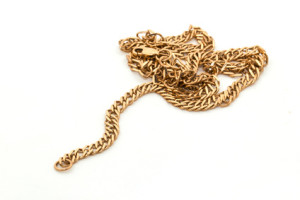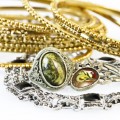Before you buy a gold chain necklace, there are several important factors to consider, including whether the chain is solid gold, what karat it is, and what kind of links the chain is made up of. Here we look at the most important characteristics you should pay attention to when buying a gold chain.
Is the Gold Chain Solid, Plated or Hollow?
One of the most important questions you need to answer when looking at a gold chain is whether it is solid gold or just gold plated.

When deciding what karat your gold chain should be, keep in mind that the purer the gold, the softer and less durable it will be.
Plated gold chains are cheaper, but the plating will wear off after some time, exposing the metal underneath, and you will need to have the chain replated if you want to restore its color.
This also holds true for white gold, which usually has rhodium plating. You can have the chain replated, but it will cost you additional money, and the success of the procedure will depend on the chain’s structure and its link type.
If you are going to wear your chain often, solid gold is a better choice as far as durability is concerned.
Some gold chains are made hollow – you will notice that they feel much lighter than solid pieces of similar size.
Hollow chains are less expensive, but there is a potential problem with them: These chains are easy to break or dent, and if that happens, they are nearly impossible to repair.
If you decide to go with a hollow gold chain, you will have to be extra careful when wearing it.
Choosing the Karat of Your Gold Chain
When deciding what karat your gold chain should be, keep in mind that the purer the gold, the softer and less durable it will be.
So, if you are going to wear your chain every day, you might want to skip the 20Kt and 22Kt pieces, which will scratch more easily compared with 10Kt or 14Kt chains, which are harder since they contain a higher percentage of non-gold alloys.
Although low-karat gold is more durable, it is not recommended if you are allergic to nickel – many gold alloys contain this metal, and the lower the gold purity, the more nickel the piece may contain.
If you are concerned about having an allergic reaction, do not buy 10Kt gold (unless you are sure it is nickel free). Stick with 14Kt or 18Kt gold instead. (Please note that 14Kt gold may still cause an allergic reaction if you are really sensitive to nickel.)
Picking the Link Type

An extremely important characteristic of a chain is the kind of links it is made up of.
The type of link you choose for your gold chain will determine how easily it will kink and how likely it will be to break.
For example, flat chains such as the omega chain and the herringbone chain are more prone to twisting.
Another problematic link type is the round snake chain. These chains will be more likely to catch on your clothes and twist, and a kinked necklace could be very hard or impossible to repair.
It is also important to decide how thick the links should be, and this depends not only on your style preference but also on whether you will be wearing a pendant. If you are going to put some kind of charm on your gold chain, make sure it is thick enough to bear the additional weight.
Chains that are too thin get twisted and tangled easily, and sometimes, they can even get tied in a knot. Also, if you have long hair, a thin chain can often get caught in it. In order to avoid such problems, don’t go for the thinnest models available, and pick a chain that’s reasonably thick.
Some of the best choices for a chain link type include the box chain and the wheat chain: They are both sturdy (in case you want to hang a pendant on them) and relatively flexible — a good choice to wear if you move a lot and don’t want to worry that they will bend or twist.
Other good link choices include the Figaro chain, the mariner chain, the anchor chain, the curb chain, and the rope chain.
Inspect the Clasp
Make sure your gold chain has a clasp that closes well and is not easy to break. The lobster clasp is one of the best choices – it is solid and does not open easily if you happen to pull your chain harder.
A lot of chains come with a ring clasp that is spring-loaded – these clasps are cheaper, but they are usually thin and not as durable and secure as the lobster clasp.
Check If the Chain Is Smooth
An often overlooked characteristic of gold chains is their surface: Make sure it is smooth.
You might think this is not a big deal, but if the chain is rough and you wear it for several hours, it will irritate your skin. Run your fingers over the chain to make sure there are no jagged pieces that could rub your skin or catch on your clothes.
You should also make sure than the chain won’t snag in your clothes. Test the chain before you decide on a purchase – put it on your clothing and see if it catches the threads of the fabric when you pull the chain gently.
Pendant or No Pendant
An important question you need to answer before buying a chain is whether you will be wearing a pendant on it.
If the answer is “yes,” then consider a chain whose thickness is commensurate with the size of the pendant. The chain shouldn’t be too thin, but at the same time, it should not be so thick as to prevent the pendant from standing out.
The structure of the chain should ensure that it will be strong enough to carry the pendant without any problems.
Wheat chains are a good option as their links are structured in such a way as to make the chain durable. Box link chains are another good choice to put a pendant on.














